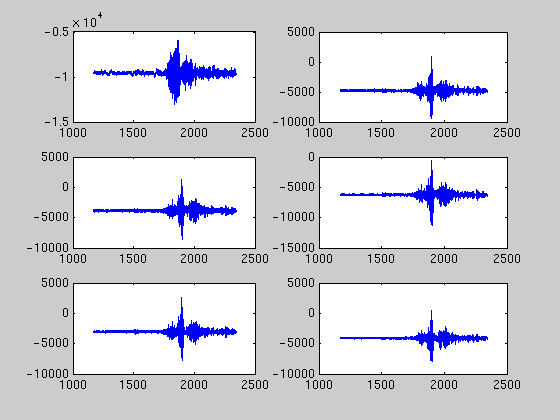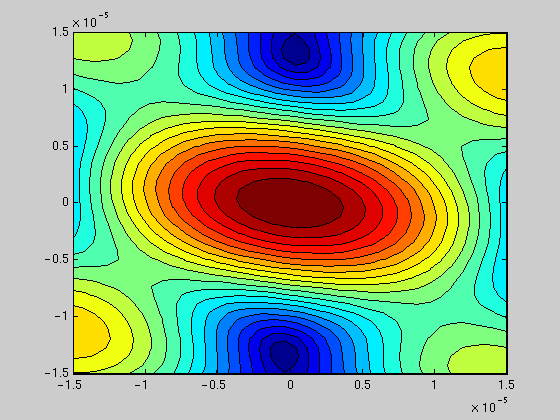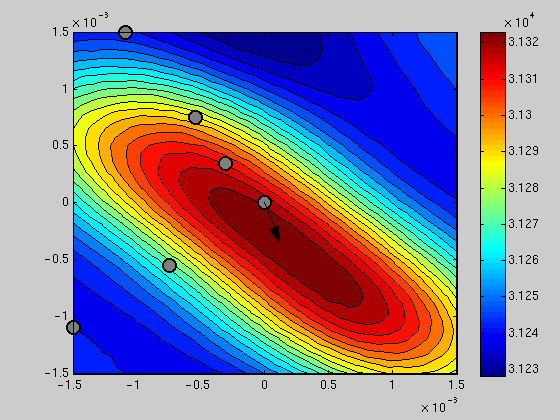Contents
Set up procesing parameters
array station locations
x = [4000 0; 0 4000; 0 0; 2000 0; 0 2000; 1000 100]; % Change the LIGO coordinate system (in which the X arm is in the x % direction and the Y arm is in the y direction to one in which North is % "up" (positive y direction). The paper arXiv:gr-qc/0403046 says that the % X arm has compass bearing 324 degrees (northwest). theta = (324.0 - 360 - 90)*pi/180; R = [cos(theta), sin(theta); -sin(theta), cos(theta)]; x = (R * x')'; % kgrid parameters kpoints = 40; % number of sample points in each direction kmax = 3/2000; % maximum wavenumber in each direction
Read the data
data = dlmread('quake-wf.txt'); data = data'; samprate = 256; % Crop the data data = data(:,3e5:6e5); % Separate out the time channel times = data(1,:); data(1,:) = [];
Plot the timeseries
for i=1:6, subplot(3,2,i); plot(times,data(i,:)); end

Plot some spectra
fdata = abs(fft(data'))';
%faxis =
Decimate the timeseries
decimation = 10; dsamprate = ceil(samprate/decimation); [rows cols] = size(data); ddata=zeros(rows,ceil(cols/decimation)); % Apply the decimation to each row. for r=1:rows, ddata(r,:) = decimate(data(r,:),decimation); end
Investigate pairwise cross-correlation
for i=1:rows, for j=1:rows, [c,lags]=xcorr(ddata(i,:),ddata(j,:),500,'unbiased'); [bestc,index]=max(c); bestlag(i,j) = lags(index(1)); end end bestlag,
bestlag =
0 -83 -87 -104 -85 -118
83 0 -7 -24 -4 -29
87 7 0 -17 3 -21
104 24 17 0 20 -4
85 4 -3 -20 0 -24
118 29 21 4 24 0
Build the k-grid
k = (((-kpoints+1)/2):((kpoints-1)/2)) * 2 * kmax / (kpoints -1); kgrid = zeros(kpoints, kpoints, 2); [kgrid(:,:,1), kgrid(:,:,2)] = meshgrid(k,k);
Compute the array's antenna response function
rgrid = zeros(kpoints,kpoints); omega = 2 * pi * (dsamprate/2); % consider the nyquist frequency zoom = 100; for i=1:kpoints, for j=1:kpoints, rgrid(i,j) = abs(sum(exp(sqrt(-1)*omega* squeeze(kgrid(i,j,:)/zoom)' * x'))); end end subplot(1,1,1); contourf(kgrid(:,:,1)/zoom,kgrid(:,:,2)/zoom,rgrid,20);

Do the beamforming
% The beamformer is really slow. Use of the profiler indicates that nearly % all of the time is spent copying data. To write a fast beamformer, I % think we'd have to write it in C. pgrid = beamform(kgrid, x, ddata, dsamprate);
Find the best beam power
[R,C] = ind2sub(size(pgrid),find(pgrid ==max(max(pgrid))));;
kbest = squeeze(kgrid(R,C,:));
% Compute the corresponding azimuth (compass bearing)
azimuth = 90 - atan2(kbest(2),kbest(1))*180/pi
azimuth = 161.5651
Plot the beam power versus k-vector
hold off; contourf(kgrid(:,:,1),kgrid(:,:,2),pgrid,20); hold on; colorbar; % Superimpose a diagram of the sensor array for directional reference xmax = max(max(x)); plot(x(:,1)*kmax/xmax,x(:,2)*kmax/xmax,'ko','LineWidth',2,'MarkerSize',12,'MarkerEdgeColor','k','MarkerFaceColor',[0.5 0.5 0.5]) % Draw an arrow indicating the best k-vector arrow([0 0],kbest); hold off;

% Another idea for estimating the incoming wavevector was to create a % weighted sum of all k-vectors on the grid, each weighted by the beam % power it produced. However, this doesn't seem to produce a good answer. kvote = [sum(sum(pgrid .* squeeze(kgrid(:,:,1)))) , ... sum(sum(pgrid .* squeeze(kgrid(:,:,2)))) ] / sum(sum(pgrid));